
Source: Chainalysis; Compilation: Tao Zhu, Bitchain Vision
Sub-Saharan Africa accounts for the smallest share of the global cryptocurrency economy, accounting for 2.7% of global transaction volume between July 2023 and June 2024 — reflecting the region’s smaller GDP relative to other regions.despite this,Sub-Saharan Africa still achieved moderate growth, with an estimated on-chain value of $125 billion during this period, an increase of $7.5 billion from last year.
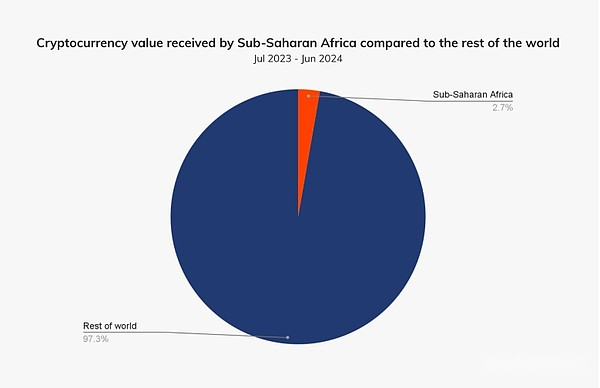

Cryptocurrencies are undoubtedly changing the financial landscape of the region, which has many countries that rank high in our global adoption index.Nigeria maintains its position as the top global player, ranking second in the world, while Ethiopia (26), Kenya (28) and South Africa (30) also make the top 30.
The actual use cases of cryptocurrencies in Africa are particularly striking.Africans are using cryptocurrencies for commercial payments as tools to hedge inflation, and make more frequent, smaller (i.e. retail-scale) transfers.
It is worth noting thatSub-Saharan Africa is a world leader in DeFi adoption, which may be partly due to the growing demand for accessible financial services in the region, which, as of 2021, only 49% of adults in the region own banks, according to the World Bank.Account.
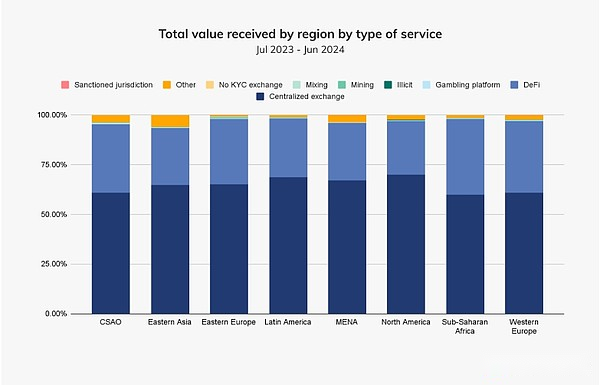
With its frontier position as a financial innovation and inclusion, Sub-Saharan Africa is becoming a global model of how cryptocurrencies can drive real-world impact, especially in areas underserved by traditional financial systems.
Stablecoins are driving economic resilience and global connectivity in sub-Saharan Africa
Stablecoins have become a key element of the crypto economy in sub-Saharan Africa.In countries where local currencies are highly volatile and the U.S. dollar-pegged stablecoins such as USDT and USDC have gained favour, providing businesses and individuals with a reliable way to store value, facilitate international payments and support cross-bordertrading.
Stablecoins currently account for about 43% of the total transaction volume in the region.
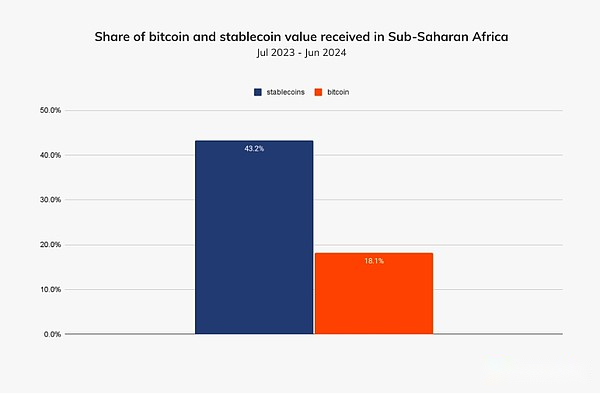
To further understand the growing position of stablecoins, we interviewed two key figures shaping the cryptocurrency landscape in Africa: ABSA Bank, CIB Digital Assets Director Rob Downes, a large African bank operating in 12 African countries, and Yellow CardCEO and co-founder Chris Maurice, one of Africa’s leading crypto-asset exchanges operating in 20 countries on the continent.
The main driver of Africa’s adoption of stablecoins is the Forex (FX) crisis faced by many countries.
“About 70% of African countries face foreign exchange shortages and businesses are working to get the dollar they need to operate,” Maurice explained.“Stablecoins provide these businesses with the opportunity to continue operating, growing and strengthening their local economies.” Small and medium-sized stablecoin inflows (we measured less than $1 million) tend to be consistent with the depreciation of the Naira, as shown below.
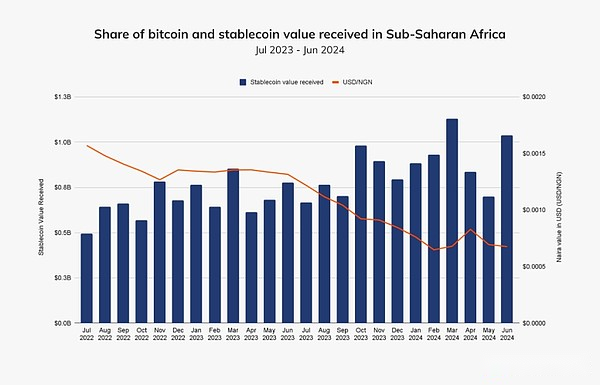
As Naira depreciates, we can see an increase in inflows of stablecoins traded below $1 million, and this activity is even more evident during a period of a sharp depreciation of the currency.
Ethiopia is the second largest populous country in Africa with a population of 123 million. It is currently the fastest growing market for the country’s retail-scale stablecoin transfers, with a year-on-year increase of 180%.
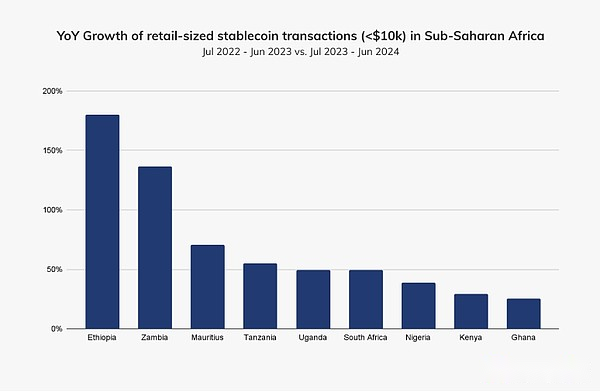
Ethiopia’s local currency, Bill (ETB), depreciated 30% in July after the government relaxed currency restrictions to obtain $10.7 billion in loans from the IMF and the World Bank.This depreciation could further stimulate demand for stablecoins.
For many African companies, obtaining stablecoins through platforms such as Yellow Card provides an alternative to traditional financial institutions (FIs) that cannot meet their dollar needs.”Stablecoins are a replacement for the dollar,” Morris said.“If you can get USDT or USDC, you can easily exchange it for hard currency elsewhere.” This reality makes stablecoins indispensable for companies involved in international trade.From small-scale importers who buy overseas goods to large multinational corporations that import raw materials from Europe, stablecoins are promoting transactions that would have been stagnant due to currency shortages.
Stablecoins are also revolutionizing cross-border payments throughout Africa.“People don’t care about cryptocurrencies,” said Morris, who stressed that the region’s focus is on the actual use cases of cryptocurrencies.He cited the businesses Yellow Card serves, such as a large food producer using stablecoins to pay overseas suppliers.In addition, many African fintech companies rely on stablecoins to manage large amounts of local currencies and then exchange them into stablecoins to facilitate cross-border payments.
Rob Downes of Absa Group noted that there is a similar trend for institutional clients in South Africa.“Our institutional clients are particularly interested in using stablecoins as a tool to manage liquidity and reduce the risk of currency volatility,”Downes tell us.In countries where local currency values fluctuate, stablecoins may be an attractive option for businesses looking to hedge currency risks.
Downes also noted that stablecoins are being used in remittances and international payments.“We think stablecoins will change the game,” he said.For individuals who send or pay their fees to overseas families, stablecoins offer a faster and more affordable alternative than traditional remittance services.
Starting from the end of 2023, stablecoins have continued to grow on local exchanges in South Africa – up more than 50% month-on-month in October 2023.Stablecoins have replaced Bitcoin as the most popular cryptocurrency in recent months.
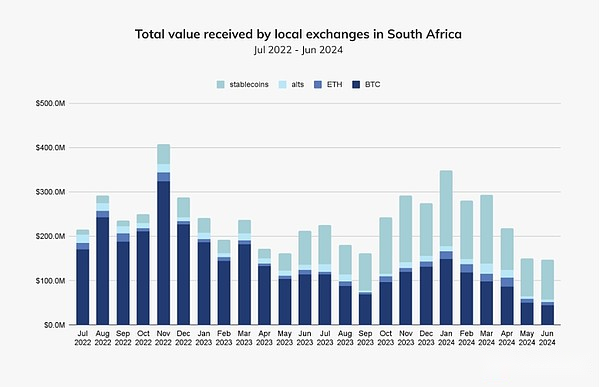
Although the use of stablecoins is rapidly expanding across Africa, the regulatory landscape is also gradually evolving.In South Africa, the Financial Sector Conduct Authority (FSCA) provides regulatory clarity by classifying crypto assets as financial products, although there are no specific regulatory provisions for stablecoins.“We are working closely with regulators such as the Reserve Bank of South Africa to ensure we are ready for any developments in stablecoin regulation, which we expect will soon become a major area of focus,” Downes added.Maurice notes that in many cases, stablecoins are in a “gray zone” with neither clear regulation nor bans.He stressed the importance of working with regulators to ensure stablecoin users remain compliant.“We did a lot of work with local regulators,” Maurice said.“We are working with central banks and financial authorities in 20 countries to help them understand how to use stablecoins safely and effectively.”
Looking ahead, both Downes and Maurice believe stablecoins will continue to play a central role in the African economy.”I think stablecoins will be the main use case for South African cryptocurrencies in the next three to five years,” Downes said.
Maurice agreed, adding that stablecoins are helping African economies open to global markets.”Stablecoins are actually developing a market for African currencies that have never had a place internationally,” he said.By providing businesses with ways to trade in non-volatile currencies, stablecoins are improving price transparency and encouraging foreign investment.“It is creating a more open economy that actually encourages investment,” Maurice added.
Nigeria is the center of cryptocurrency activity in sub-Saharan Africa
In recent years, Nigeria has become a global leader in cryptocurrency adoption, thanks to innovative use cases to address economic challenges.The country ranks second overall in our global adoption index, with the country receiving approximately $59 billion worth of cryptocurrencies between July 2023 and June 2024.
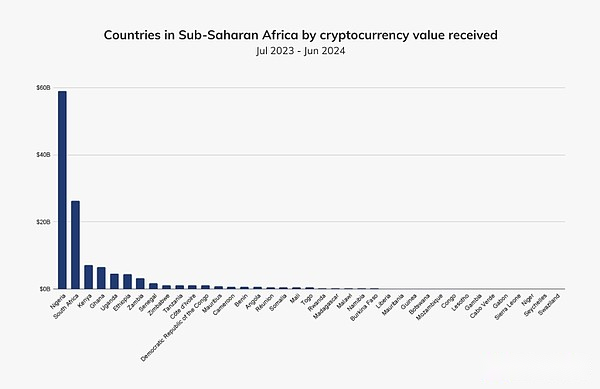
Crypto activity in Nigeria is driven primarily by small retail and professional-scale transactions, with approximately 85% of the transfers being worth less than US$1 million.
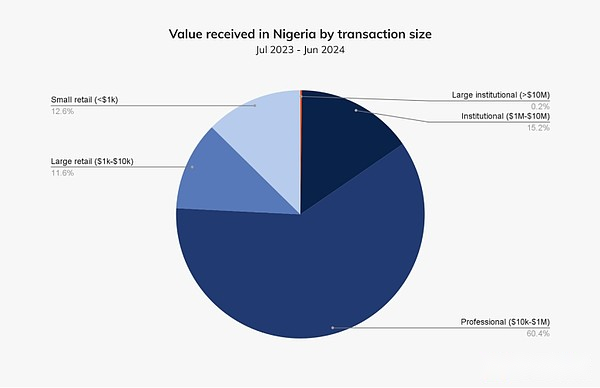
We interviewed Moyo Sodipo, chief operating officer and co-founder of Nigerian cryptocurrency exchange Busha to see what is actually going on in the country’s cryptocurrency adoption.Sodipo said daily activities such as bill payments, mobile phone top-ups and retail shopping are increasingly powered by cryptocurrencies.”People are starting to see the practicality of cryptocurrencies in the real world, especially in daily transactions, which is different from the previous view that cryptocurrencies are regarded as a means of getting rich quickly,” he explained.
Like Ethiopia, Ghana and South Africa, stablecoins are also an important part of Nigeria’s cryptocurrency economy, accounting for about 40% of all stablecoin inflows in the region – the highest in sub-Saharan Africa.
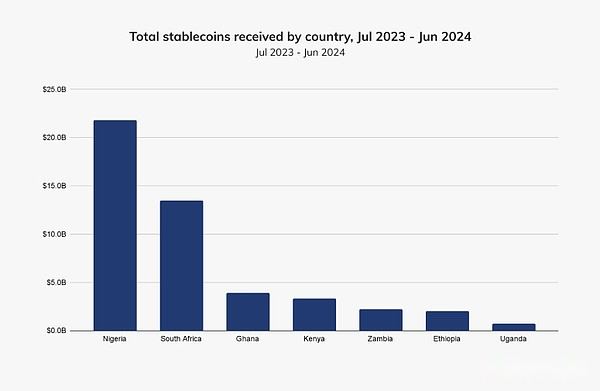
Due to the inefficient and costly traditional remittance channels, many Nigerians rely on stablecoins for cross-border remittances.”Cross-border remittances are the main purpose of Nigerian stablecoins. It is faster and more affordable,” Sodipo noted.
As shown in the figure below,The average cost of sending $200 from sub-Saharan Africa using stablecoins is about 60% lower than traditional remittance methods using fiat currency.1
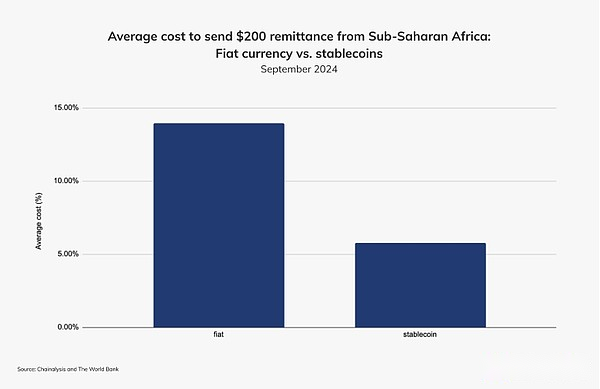
Like other African countries, the main drivers of Nigeria’s adoption of stablecoins are inflation and the depreciation of the naira – which fell to an all-time low in February 2024.We can see the impact of this trend by looking at the transfer size below $1 million.In the first quarter of 2024, the stablecoin was worth nearly $3 billion, making the stablecoin the largest segment of Nigeria’s under $1 million transactions.
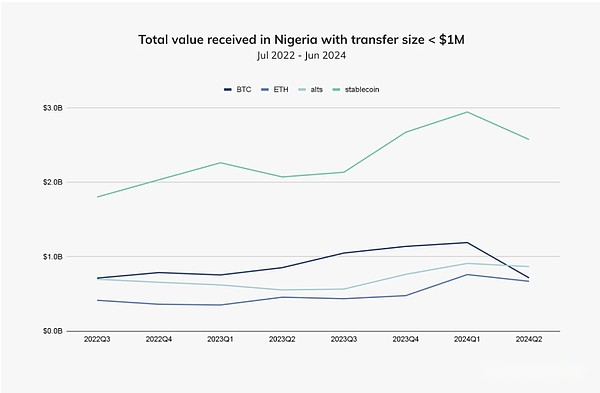
Although bitcoin and altcoins still have significant significance and represent billions of dollars in value, stablecoins are clearly becoming the preferred medium for small and medium transactions, indicating that they will be widely adopted.
In addition to the growing prominence of stablecoins, DeFi has also experienced a significant moment in Nigeria, which echoes a broader trend in sub-Saharan Africa as a global leader in DeFi adoption.Nigeria is at the forefront of this trend, with DeFi services worth over $30 billion last year.

In addition to the traditional financial system, the DeFi platform also provides Nigerians with new opportunities to earn interest, loans and participate in decentralized transactions.“DeFi is a key area of growth as users are exploring ways to maximize returns and access financial services that were otherwise unavailable,” Sodipo said.
In December 2023, the central bank lifted a ban on banks that serve cryptocurrency companies, which also played a key role in the momentum.“Since the bank ban was lifted, it opened up many possibilities for collaboration and smoother transactions,” Sodipo explained.On this basis, in June 2024, the Securities and Exchange Commission of Nigeria (SEC) launched the Accelerated Regulatory Incubation Program (ARIP), which now requires all virtual asset service providers (VASPs) to register and be evaluated before they are fully approved..“The industry is optimistic about ARIP; it is a shift away from uncertainty and a positive step towards regulatory clarity,” Sodipo said.
Despite Nigeria’s progress on initiatives such as ARIP, many financial institutions are reluctant to get into the cryptocurrency sector as regulatory ambiguity lingers.“Banks remain cautious and wait for a clear signal from the central bank and the Securities and Exchange Commission before entering the market in full,” Sodipo explained.
Nevertheless, Nigeria’s cryptocurrency market is still booming.Looking ahead, Sodipo is optimistic about the future of cryptocurrencies in Nigeria, especially in the ongoing regulatory reforms.”Open dialogue with regulators is key. We hope that further clarity will push more banks and financial institutions into this area,” Sodipo said.
South Africa’s cryptocurrency market booms, driven by growing institutional activities and TradFi engagement
As Africa’s largest economy, South Africa has become one of the largest cryptocurrency markets on the continent, earning about $26 billion in value over the past year.The number of licensed companies in South Africa has increased significantly, and the activity of the institutional scale has continued to increase.
The chart below shows the growing impact of institutional and professional-scale transactions on South Africa that have become the largest contributor to the value of the total index, especially from the end of 2023 to the first quarter of 2024.2
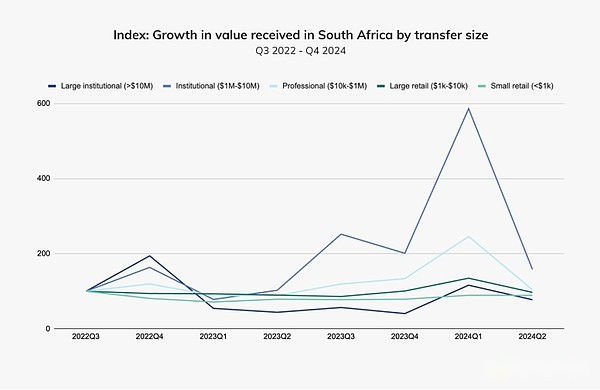
This link between traditional finance and cryptocurrencies is particularly active in South Africa.According to Rob Downes of the Absa Group,South Africa is at a critical moment when traditional finance and digital assets begin to merge.“We are seeing growing interest among institutional clients, especially in digital asset custody solutions, which will play a key role in supporting the crypto ecosystem here,” Downes said.
Although institutional participants drive most of the market activity, retail and professional engagement remains stable.To gain insight into the business environment, we interviewed Carel van Wyk, founder of MoneyBadger, which focuses on integrating crypto payments for retailers.Van Wyk noted that South Africa’s crypto market has been steadily matured, especially in the payments sector.“In the past, people tried to pay on-chain, but that was impractical because blockchain transactions could become expensive and not suitable for small, fast transactions.” He talked about the advancements in layer2 technology and payment APIs, whichAdvances make crypto payments more suitable for everyday use, allowing retailers to accept encryption while they settle in fiat currency.
The FSCA decided to regulate crypto assets under existing financial laws, which is the main catalyst for market growth.This provides businesses and investors with much-needed clarity, enabling licensed companies to grow responsibly and encourages financial institutions to explore crypto services.“The regulatory environment here is relatively favorable compared to other regions. This gives us confidence to explore more powerful solutions like custody and payment,” Downes said.
The trading pairs with the South African Rand (ZAR) are also booming, with transactions of hundreds of millions of dollars a month.
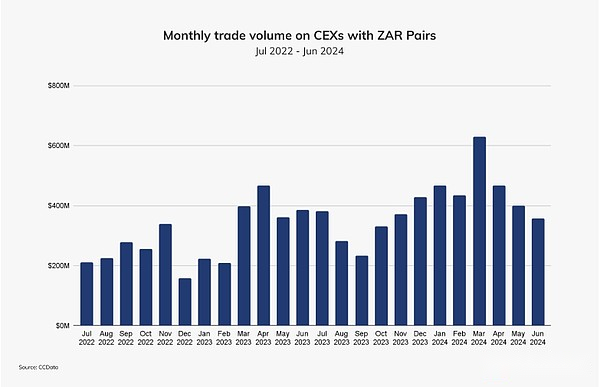
The performance of the ZAR pair shows that South Africa’s crypto ecosystem is becoming more mature, which Downes believes will drive further institutional participation.“We’re seeing exchanges becoming more and more complex, which is very important in building trust with retail and institutional investors,” he explained.
South Africa’s regulatory transparency and market growth have attracted interest from financial institutions.Absa Group Bank, one of South Africa’s largest banks, is actively exploring blockchain and cryptocurrency initiatives.Downes stressed that the main focus of Absa Group is on providing institutional-level crypto-hosting services, which they see as a key opportunity in the near future.“The thing I’m most excited about — and our biggest near-term income opportunity — is hosting,” Downes shared.Absa Group regards secure hosting services as the basis for institutional cryptography, providing security and compliance to exchanges, investment companies and other large market participants.
Absa Group and other South African banks are increasingly interested in participating in the crypto industry, although risks management and compliance challenges remain.Downes acknowledges that banks need to establish trusted relationships with cryptocurrency exchanges and service providers to promote services such as banking and payments.Downes said the Absa Group has taken a “learning and experimenting” approach and has gained support from leadership.“We deliberately positioned our efforts as relatively relaxed, focused on learning and participating in the market,” explains Downes. This exploratory approach allows the Absa Group to participate in the regulatory sandbox and work closely with regulators to ensure compliance, while advancing its blockchain initiatives.
Customer demand for encryption-related services is growing steadily.“The consulting volume has tripled in the past 18 months,” Downes noted, adding that this interest covers banking services for cryptocurrency payments, investments and exchanges.Institutional clients, especially family offices and asset management companies, are starting to explore how to integrate digital assets into their portfolios.”Traditional financial institutions are still in relatively early stages in the crypto space, but the demand from customers is driving us to speed up,” Downes added.
As banks such as Absa Group continue to innovate and explore blockchain technologies, they are helping to bridge the gap between traditional finance and cryptocurrencies.“Traditional financial institutions have unique advantages to leverage our regulatory expertise and controls to help introduce blockchain-based finance,” Downes said.With the increasing integration of the technology, both corporate and consumer adoption will accelerate, further consolidating South Africa’s position in the global crypto economy.
Key nodes in sub-Saharan Africa
Although sub-Saharan Africa accounts for a relatively small share of the global crypto economy, the region is in a strong momentum.Nigeria and South Africa are leading the trend, driving a large number of on-chain activities and positioning the region as a center of increasing influence in cryptocurrency adoption and financial technology.
Stablecoins have become an important part of the crypto story in sub-Saharan Africa, a popular tool to hedge long-term inflation and currency depreciation, and currently accounts for the majority of crypto transactions across the continent.Meanwhile, DeFi is booming, and the region is leading the way in adopting decentralized platforms globally.
While countries such as South Africa, Nigeria, Ghana, Mauritius and Seychelles have made significant progress in establishing regulatory frameworks, others are exploring regulatory avenues to address growing transaction volumes and crypto needs.As various market participants, including banks and other financial institutions, deepen their participation, the need for clear regulation has never been more urgent.
The real-world crypto use cases in Africa provide valuable lessons for global markets.With a booming fintech landscape, expanding mobile penetration and the potential for collaboration between regulators, traditional finance (TradFi) and cryptocurrency companies, the continent is expected to become a global cryptocurrency leader and is expected to drive innovation andFinancial inclusion.
Comments
1 The fiat currency remittance price is derived from World Bank’s first quarter 2024 data and is used to represent the average cost of the remitter, which includes banks, remittance operators (MTOS), mobile operators and post offices.For stablecoin remittances, the total cost calculation includes exchange deposit fees, transaction fees, transfer fees, and on-chain transactions on sub-Saharan Africa exchanges.Both approaches consider foreign exchange margins, reflecting the percentage difference between the exchange rate of the remittance service provider and the interbank exchange rate.For stablecoins, Forex margin is calculated using the price difference between the closing price of September 18 provided by Wise and the intermediate market exchange rate at 12:00 a.m. UTC time on September 19.
2 The surge in institutional inflows from the end of 2023 to the first quarter could be driven by a wide market rebound triggered by U.S. approval of Bitcoin ETFs and news that South Africa will issue its first crypto asset service provider (CASP) license, driving investment regulationand protect emotions.








